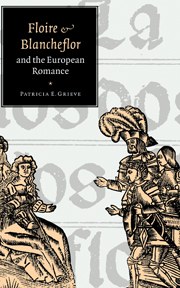Book contents
- Frontmatter
- Contents
- Preface
- Introduction
- Part One Floire and Blancheflor as Peregrinus
- Part Two The road to conversion
- 2 Cunning and ingenuity or Divine Intervention?
- 3 Signs, wonders and the telling of the tale
- 4 Routes of conversion: time and space
- 5 Generic crossroads
- Epilogue: Poetics of continuation
- Appendices
- Bibliography
- Index
- CAMBRIDGE STUDIES IN MEDIEVAL LITERATURE
4 - Routes of conversion: time and space
Published online by Cambridge University Press: 15 December 2009
- Frontmatter
- Contents
- Preface
- Introduction
- Part One Floire and Blancheflor as Peregrinus
- Part Two The road to conversion
- 2 Cunning and ingenuity or Divine Intervention?
- 3 Signs, wonders and the telling of the tale
- 4 Routes of conversion: time and space
- 5 Generic crossroads
- Epilogue: Poetics of continuation
- Appendices
- Bibliography
- Index
- CAMBRIDGE STUDIES IN MEDIEVAL LITERATURE
Summary
If Chapter Three asked “What is remembered by the reader?” in terms of images and allusions, this chapter asks “What is remembered by the text itself?” There are two major sections: first, the chapter summarizes how the texts of Floire and Blancheflor conflate notions of time and space through the linking of beginnings and endings, and considers the larger issue of genealogy and textual lineage, the circularity of the pilgrimage motif, and the use of the garden within the time-frame of the Lenten season; secondly, because so many of the narrative moments in both Crónica de Flores y Blancaflor and Il Filocolo coincide (even though as this study has repeatedly attempted to elaborate, the authorial intent of each differs) it examines those moments. For the sake of avoiding repetition, I will limit the discussion of the two works in the more general first section of this chapter.
MORAL GEOGRAPHY AND SPIRITUAL REDEMPTION
Ritual and sacred space are linked in Floire and Blancheflor with a geographical process and the concepts of moral and spiritual redemption. This linking process forms the core of the southern and Old Norse versions of the legend. Just as people are converted – a kind of spiritual, emotional or rational transformation – spaces in the story are converted. Often, but not always, the moral significance of a place ties in with an episode of false or near-death, which in turn is associated with a moral or spiritual death whose reversal lies in the near-death, which in turn is associated with a moral or spiritual death whose reversal lies in the near narrative and temporal future.
- Type
- Chapter
- Information
- 'Floire and Blancheflor' and the European Romance , pp. 134 - 158Publisher: Cambridge University PressPrint publication year: 1997



